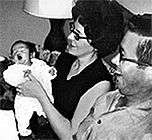Waneta Hoyt
| Waneta Hoyt | |
|---|---|
|
family photo | |
| Born |
Waneta Ethel Nixon May 13, 1946 Richford, New York |
| Died |
August 13, 1998 (aged 52) Bedford, New York |
| Criminal penalty | life sentence |
| Killings | |
| Victims | 5 |
Span of killings | 1965–1971 |
| Country | United States |
| State(s) | New York |
Date apprehended | 1994 |
Waneta Ethel (Nixon) Hoyt (May 13, 1946 – August 13, 1998[1]) was an American serial killer who was convicted of killing all five of her biological children.
Background
Hoyt was born in Richford, New York, and died at the Bedford Hills Correctional Facility for Women. She dropped out of Newark Valley High School in the 10th grade to marry Tim Hoyt on January 11, 1964.
Deaths
James Hoyt died on September 26, 1968, only 28 months after he was born on May 31, 1966. None of the Hoyts' other children — Eric (October 17, 1964 – January 26, 1965), Julie (July 19 – September 5, 1968), Molly (March 18 – June 5, 1970), and Noah (May 9 – July 28, 1971) — lived past that mark. For more than 20 years, it was believed that the babies had died of sudden infant death syndrome. Several years after the death of their last child, Mr. and Mrs. Hoyt adopted a child, Jay, who remained healthy through childhood and was 17 years old when Mrs. Hoyt was arrested in 1994.[2]
The last two biological Hoyt children, Molly and Noah, were subjects of pediatric research conducted by Dr. Alfred Steinschneider, who published an article in 1972 in the Journal Pediatrics proposing a connection between sleep apnea and SIDS. The article was discredited and subsequent research failed to replicate the results.
Investigation and trial
In 1985 a prosecutor in a neighboring county who had been dealing with a murder case that was initially thought to involve SIDS was told by one of his experts, Dr. Linda Norton, a forensic pathologist from Dallas, that there may be a serial killer in his area of New York. Dr. Norton suspected this after reviewing Steinschneider's report on the Hoyt case (in which the Hoyts were not identified by name). When the prosecutor became District Attorney in 1992, he tracked the case down and sent it to forensic pathologist Michael Baden for review. Baden concluded that the deaths were the result of murder. In 1994, because of jurisdictional issues, the case was transferred to the District Attorney of the county where the Hoyts resided. In March 1994 Hoyt was approached while at the Post Office by a New York State trooper with whom she was acquainted. He asked her for help in research he was doing on SIDS, and she agreed. She was then questioned by the trooper and two other policemen. At the end of the interrogation she confessed to the murders of all five children by suffocation. Consequently she was arrested.[2] The reason she gave for the murders was that the babies were crying and she wanted to silence them.[3]
Hoyt later recanted her confession and its validity was an important issue during the trial. An expert hired by the Defense, Dr. Charles Patrick Ewing, testified that: "It is my conclusion that her statement to the police on that day was not made knowingly, and it was not made voluntarily." He diagnosed Mrs. Hoyt with dependent and avoidant personality disorders, and opined that she was particularly vulnerable to the tactics used during her interrogation. Dr. David Barry, a psychiatrist hired by the prosecution agreed that Waneta Hoyt had been manipulated by the police tactics. Nevertheless, Hoyt was convicted in April 1995.
On September 11, 1995, she was sentenced to 75 years to life[2] (15 years for each murder, to be served consecutively). It has been speculated since her conviction that Hoyt suffered from Münchausen syndrome by proxy, a diagnosis not universally accepted in this case.[4]
Aftermath
Hoyt died in prison of pancreatic cancer in August 1998.[5] She was formally exonerated under New York law because she died before her appeal had been heard.
References
- ↑ Crimezzz.net Waneta Hoyt March 5, 2010
- 1 2 3 Sanz, Cynthia (9 October 1995), "A Mother's Fatal Embrace", People Magazine
- ↑ Geringer, Joseph, "Black Widows: Veiled in Their Own Web of Darkness", truTV Crime Library, retrieved 5 May 2012
- ↑ Bearak, Barry (22 May 1994), "COLUMN ONE : A Mother Who Lost Five Babies : One after another, Waneta Hoyt's children died. Sudden Infant Death Syndrome was blamed. Years later, Hoyt said she killed them--then recanted. Now, she faces murder trial amid a swirl of questions", Los Angeles Times
- ↑ "Waneta Hoyt". The Orlando Sentinel. August 12, 1998. Retrieved February 16, 2015.
- Steinschneider, Alfred (1972), "Prolonged Apnea and the Sudden Infant Death Syndrome: Clinical and Laboratory Observations", Pediatrics, 50 (4): 646–654, PMID 4342142 (subscription required)
- Ewing, Charles Patrick (2008). Trials of A Forensic Psychologist: A Casebook. Hoboken, New Jersey: John Wiley & Sons. ISBN 978-0-470-17072-4.
External links
- New York Times review of the book "The Death of Innocents" March 5, 2010
- "Wishing Away a Baby Murders Case" New York Times April 11, 1995 March 5, 2010
- "Waneta Ethel Hoyt" Radford University March 5, 2010 note: it incorrectly gives Massachusetts as the place of Hoyt's birth, reverses the last two digits of her birth year, and gives September 26, 1968 as Eric's DOD when it was actually James's DOD<!- There is no indication that this is anything more than a student term paper or research assignment. -->
